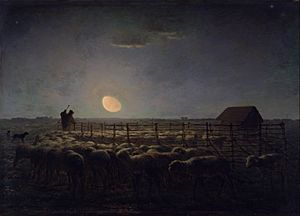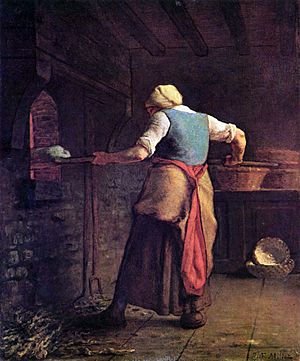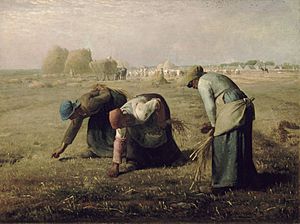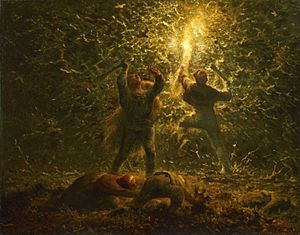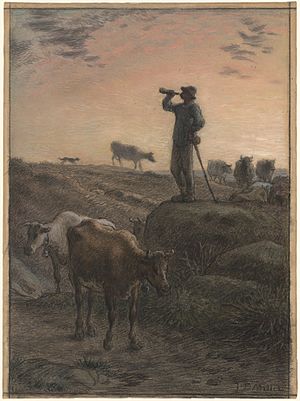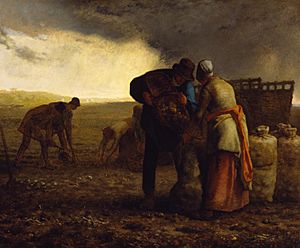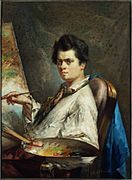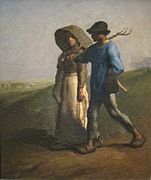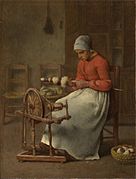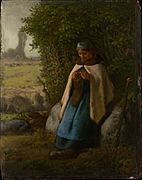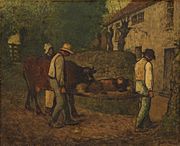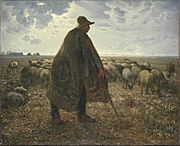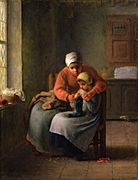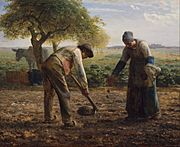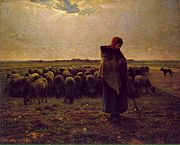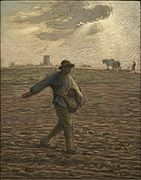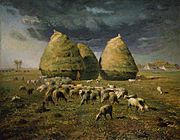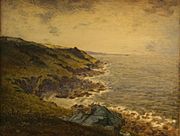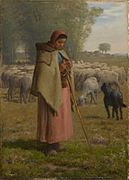Jean-François Millet facts for kids
Quick facts for kids
Jean-François Millet
|
|
|---|---|
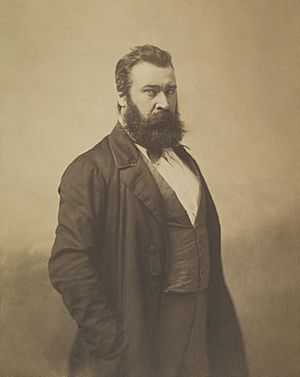
Portrait by Nadar, c. 1856-58
|
|
| Born |
Jean-François Millet
4 October 1814 Gruchy, Gréville-Hague, Normandy, France
|
| Died | 20 January 1875 (aged 60) Barbizon, Île de France, France
|
| Known for | Painting |
| Movement | Realism |
Jean-François Millet (born October 4, 1814 – died January 20, 1875) was a famous French artist. He was one of the people who started the Barbizon school of art in the countryside of France. Millet is well-known for his paintings of farmers and their daily lives. His art style is part of the Realism art movement, which means he painted things as they really were. Later in his career, he also became very interested in painting landscapes. While he is best known for his oil paintings, he also created beautiful works using pastels, crayon, and etchings.
Contents
About Jean-François Millet
His Early Life
Jean-François Millet was the first child in his family. He grew up in a farming village called Gruchy in Normandy, France, near the coast. His parents, Jean-Louis-Nicolas and Aimée-Henriette-Adélaïde Henry Millet, were farmers. Two village priests helped Millet learn Latin and read many books.
However, because he was the oldest son, Millet soon had to help his father with farm work. He learned all about farming tasks like mowing, making hay, and plowing. These everyday farm scenes later became important subjects in his paintings.
In 1833, his father sent him to Cherbourg to study painting with a portrait artist named Bon Du Mouchel. By 1835, he was studying with Théophile Langlois de Chèvreville, another artist. Langlois and others helped Millet get money to move to Paris in 1837. There, he studied at the École des Beaux-Arts. In 1839, his scholarship ended, and his first painting for the important Paris Salon art show was not accepted.
Life in Paris
Millet's first painting, a portrait, was accepted at the Salon in 1840. After this success, he went back to Cherbourg to paint portraits. The next year, he married Pauline-Virginie Ono, and they moved to Paris. Sadly, Pauline passed away in April 1844. Millet then returned to Cherbourg.
In 1845, Millet moved to Le Havre with Catherine Lemaire. They got married in 1853 and had nine children. They stayed together for the rest of Millet's life. In Le Havre, he painted portraits and small everyday scenes before moving back to Paris.
In Paris in the mid-1840s, Millet became friends with other artists like Constant Troyon, Narcisse Diaz, Charles Jacque, and Théodore Rousseau. These artists, including Millet, became known as the Barbizon school. He also met Honoré Daumier, whose drawings of people influenced Millet's paintings of peasants. A government worker named Alfred Sensier became a lifelong supporter and later wrote a book about Millet's life.
In 1847, Millet had his first big success at the Salon with his painting Oedipus Taken down from the Tree. In 1848, the government bought his painting Winnower.
Millet's most ambitious painting at the time was The Captivity of the Jews in Babylon. It was shown at the Salon in 1848 but was not liked by critics or the public. The painting disappeared soon after, and many thought Millet had destroyed it. However, in 1984, scientists found something amazing! They X-rayed Millet's 1870 painting The Young Shepherdess and discovered that Captivity was painted underneath it. It seems Millet reused the canvas when art supplies were hard to find during the Franco-Prussian War.
Moving to Barbizon
In 1849, Millet painted Harvesters for the state. At the Salon that year, he showed Shepherdess Sitting at the Edge of the Forest. This small painting showed a new direction in his art. Instead of perfect, dreamy country scenes, he started painting more realistic and personal views of nature. In June 1849, he moved to Barbizon with Catherine and their children.
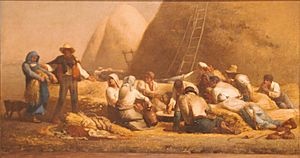
In 1850, Millet made a deal with Sensier, who gave him art supplies and money. In return, Millet gave Sensier drawings and paintings, but he could still sell his art to others. At the Salon that year, he showed Haymakers and The Sower. The Sower was his first major masterpiece and one of his most famous paintings, along with The Gleaners and The Angelus.
From 1850 to 1853, Millet worked on Harvesters Resting (Ruth and Boaz). He thought this was his most important painting and spent the longest time on it. He wanted it to be as great as works by his heroes Michelangelo and Poussin. This painting also showed his change from painting symbolic peasant life to showing real social conditions of his time. It was the only painting he ever dated and was the first to win him an official award at the 1853 Salon.
In the mid-1850s, Millet also created some etchings (a type of print) of peasant subjects, like Man with a Wheelbarrow (1855) and Woman Carding Wool (1855–1857).
The Gleaners
The Gleaners (1857) is one of Millet's most famous paintings. For seven years, while walking around the fields near Barbizon, Millet kept thinking about "gleaning." Gleaning was a very old tradition where poor women and children were allowed to pick up the small bits of grain left in the fields after the harvest. Millet saw this as a timeless act, like stories from the Old Testament. When he showed The Gleaners at the Salon in 1857, the public was not very excited, and some even disliked it.
Earlier versions of this painting included a tall (vertical) painting from 1854 and an etching from 1855–56. The etching was very similar to the wide (horizontal) painting you can see today in the Musée d'Orsay.
In the painting, a warm, golden light makes this everyday scene feel special and eternal, even though it shows the hard work of survival. Millet spent years planning how to show the feeling of endless, tiring work in the peasants' lives. The way the women's backs are bent and then straighten up again shows the repeating motion of their difficult labor. In the distance, the setting sun shines behind the farm, where there are many stacks of grain. This is a contrast to the large, shadowy figures of the gleaners in the front. The dark, simple dresses of the women stand out against the golden field, making each woman look strong and important.
The Angelus
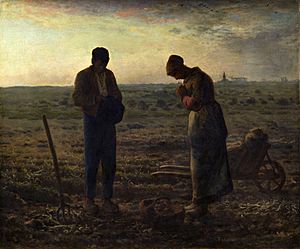
This painting was ordered by Thomas Gold Appleton, an American art collector. He had studied with Millet's friend, Constant Troyon. Millet finished the painting in the summer of 1857. He added a church steeple and changed the original title, Prayer for the Potato Crop, to The Angelus. This happened because the person who ordered it didn't pick it up in 1859.
When the painting was first shown to the public in 1865, it was sold several times. Its value only went up a little because some people didn't like Millet's political ideas. After Millet died ten years later, there was a big competition between the United States and France to buy the painting. It ended up being sold for a very high price.
Because of the huge difference between the painting's high value and Millet's family being poor after his death, a new law was created in France. This law, called the droit de suite, helps artists or their families get money when their artworks are resold for a higher price.
Interestingly, the famous artist Salvador Dalí was very interested in The Angelus. He believed that the two figures in the painting were not praying for a potato crop, but actually praying over their buried child. Dalí was so sure about this that an X-ray was done on the canvas. The X-ray showed a painted-over shape that looked a lot like a coffin! However, it's not clear if Millet changed his mind about the painting's meaning or if the shape was truly a coffin.
Later Years and Success
Even though some of his paintings got mixed reviews at the Salon, Millet's fame and success grew during the 1860s. Early in the decade, he agreed to paint 25 works in exchange for a monthly payment for three years. In 1865, another supporter, Emile Gavet, started ordering pastels from him. This collection eventually included 90 works.
In 1867, a big art show called the Exposition Universelle featured many of Millet's paintings, including The Gleaners, Angelus, and Potato Planters. The next year, Frédéric Hartmann ordered Four Seasons for a large sum of money, and Millet was given a special honor called Chevalier de la Légion d'Honneur.
In 1870, Millet was chosen to be on the Salon jury. Later that year, he and his family left Barbizon because of the Franco-Prussian War. They moved to Cherbourg and Gréville and didn't return to Barbizon until late 1871. His last years were successful financially, and he received more official recognition. However, his health was failing, and he couldn't finish some government art projects. On January 3, 1875, he and Catherine had a religious wedding ceremony. Jean-François Millet passed away on January 20, 1875.
Millet's Legacy
Millet was a very important artist who inspired many others. For example, Vincent van Gogh was greatly influenced by Millet, especially when he was starting his career. Van Gogh mentioned Millet and his work many times in his letters to his brother Theo.
Millet's later landscape paintings also influenced Claude Monet's paintings of the Normandy coast. His way of structuring his art and using symbols also affected Georges Seurat.
Millet is also the main character in Mark Twain's play Is He Dead? (1898). In the play, Millet is shown as a struggling young artist who pretends to die to become famous and rich. Most of the details about Millet in the play are made up.
Millet's painting L'homme à la houe (The Man with the Hoe) inspired a famous poem with the same name by Edwin Markham in 1898. His paintings also inspired American poet David Middleton's collection of poems called The Habitual Peacefulness of Gruchy: Poems After Pictures by Jean-François Millet (2005).
The Angelus painting was copied many times in the 19th and 20th centuries. As mentioned earlier, Salvador Dalí was fascinated by this work and even wrote a book analyzing it.
Gallery
- Jean-François Millet's paintings
-
Woman Spinning (The Spinning Wheel), c. 1855-60. Clark Art Institute
-
The Knitting Lesson, c. 1860. Clark Art Institute
-
The Sower, c. 1865. Clark Art Institute
-
Young Girl Guarding her Sheep, c. 1860-62. Clark Art Institute
See also
 In Spanish: Jean-François Millet para niños
In Spanish: Jean-François Millet para niños


